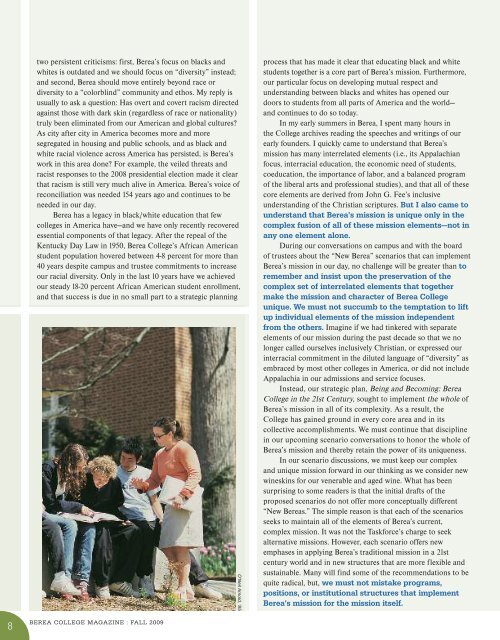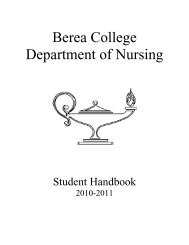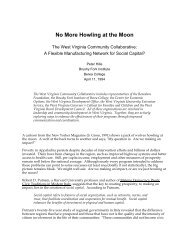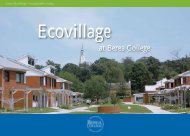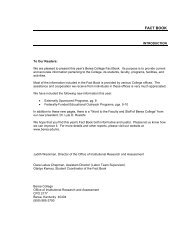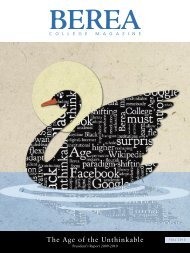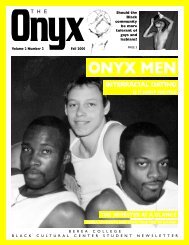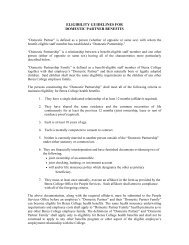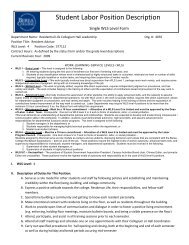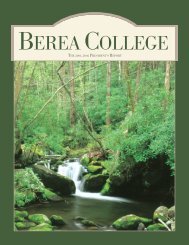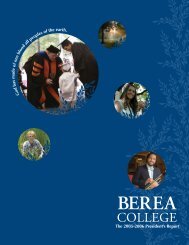2008-2009 PRESIDENT'S REPORT - Berea College
2008-2009 PRESIDENT'S REPORT - Berea College
2008-2009 PRESIDENT'S REPORT - Berea College
Create successful ePaper yourself
Turn your PDF publications into a flip-book with our unique Google optimized e-Paper software.
two persistent criticisms: first, <strong>Berea</strong>’s focus on blacks and<br />
whites is outdated and we should focus on “diversity” instead;<br />
and second, <strong>Berea</strong> should move entirely beyond race or<br />
diversity to a “colorblind” community and ethos. My reply is<br />
usually to ask a question: Has overt and covert racism directed<br />
against those with dark skin (regardless of race or nationality)<br />
truly been eliminated from our American and global cultures?<br />
As city after city in America becomes more and more<br />
segregated in housing and public schools, and as black and<br />
white racial violence across America has persisted, is <strong>Berea</strong>’s<br />
work in this area done? For example, the veiled threats and<br />
racist responses to the <strong>2008</strong> presidential election made it clear<br />
that racism is still very much alive in America. <strong>Berea</strong>’s voice of<br />
reconciliation was needed 154 years ago and continues to be<br />
needed in our day.<br />
<strong>Berea</strong> has a legacy in black/white education that few<br />
colleges in America have—and we have only recently recovered<br />
essential components of that legacy. After the repeal of the<br />
Kentucky Day Law in 1950, <strong>Berea</strong> <strong>College</strong>’s African American<br />
student population hovered between 4-8 percent for more than<br />
40 years despite campus and trustee commitments to increase<br />
our racial diversity. Only in the last 10 years have we achieved<br />
our steady 18-20 percent African American student enrollment,<br />
and that success is due in no small part to a strategic planning<br />
O’Neil Arnold, ’85<br />
process that has made it clear that educating black and white<br />
students together is a core part of <strong>Berea</strong>’s mission. Furthermore,<br />
our particular focus on developing mutual respect and<br />
understanding between blacks and whites has opened our<br />
doors to students from all parts of America and the world—<br />
and continues to do so today.<br />
In my early summers in <strong>Berea</strong>, I spent many hours in<br />
the <strong>College</strong> archives reading the speeches and writings of our<br />
early founders. I quickly came to understand that <strong>Berea</strong>’s<br />
mission has many interrelated elements (i.e., its Appalachian<br />
focus, interracial education, the economic need of students,<br />
coeducation, the importance of labor, and a balanced program<br />
of the liberal arts and professional studies), and that all of these<br />
core elements are derived from John G. Fee’s inclusive<br />
understanding of the Christian scriptures. But I also came to<br />
understand that <strong>Berea</strong>’s mission is unique only in the<br />
complex fusion of all of these mission elements—not in<br />
any one element alone.<br />
During our conversations on campus and with the board<br />
of trustees about the “New <strong>Berea</strong>” scenarios that can implement<br />
<strong>Berea</strong>’s mission in our day, no challenge will be greater than to<br />
remember and insist upon the preservation of the<br />
complex set of interrelated elements that together<br />
make the mission and character of <strong>Berea</strong> <strong>College</strong><br />
unique. We must not succumb to the temptation to lift<br />
up individual elements of the mission independent<br />
from the others. Imagine if we had tinkered with separate<br />
elements of our mission during the past decade so that we no<br />
longer called ourselves inclusively Christian, or expressed our<br />
interracial commitment in the diluted language of “diversity” as<br />
embraced by most other colleges in America, or did not include<br />
Appalachia in our admissions and service focuses.<br />
Instead, our strategic plan, Being and Becoming: <strong>Berea</strong><br />
<strong>College</strong> in the 21st Century, sought to implement the whole of<br />
<strong>Berea</strong>’s mission in all of its complexity. As a result, the<br />
<strong>College</strong> has gained ground in every core area and in its<br />
collective accomplishments. We must continue that discipline<br />
in our upcoming scenario conversations to honor the whole of<br />
<strong>Berea</strong>’s mission and thereby retain the power of its uniqueness.<br />
In our scenario discussions, we must keep our complex<br />
and unique mission forward in our thinking as we consider new<br />
wineskins for our venerable and aged wine. What has been<br />
surprising to some readers is that the initial drafts of the<br />
proposed scenarios do not offer more conceptually different<br />
“New <strong>Berea</strong>s.” The simple reason is that each of the scenarios<br />
seeks to maintain all of the elements of <strong>Berea</strong>’s current,<br />
complex mission. It was not the Taskforce’s charge to seek<br />
alternative missions. However, each scenario offers new<br />
emphases in applying <strong>Berea</strong>’s traditional mission in a 21st<br />
century world and in new structures that are more flexible and<br />
sustainable. Many will find some of the recommendations to be<br />
quite radical, but, we must not mistake programs,<br />
positions, or institutional structures that implement<br />
<strong>Berea</strong>’s mission for the mission itself.<br />
8<br />
BEREA COLLEGE MAGAZINE : FALL <strong>2009</strong>


